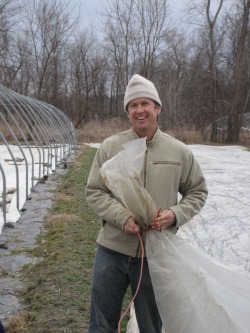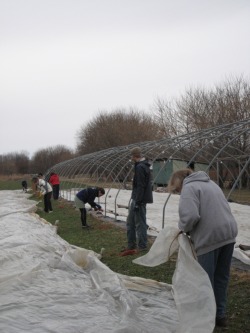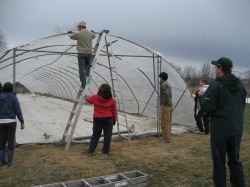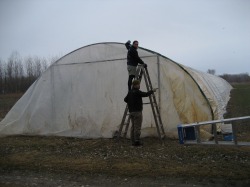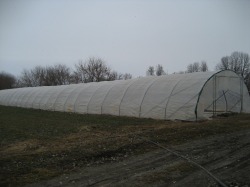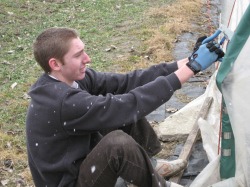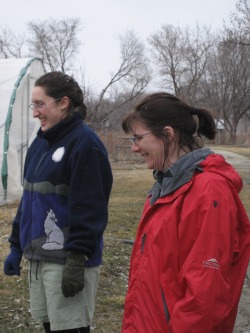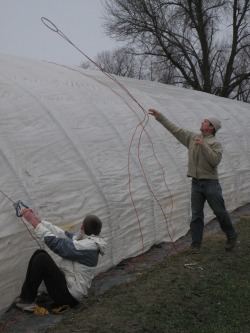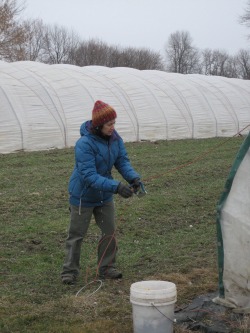Green Mountain Crop Mob
Green house skinning at Adam's Berry Farm, Burlington VT - March 2010
Adam tells us that by planting strawberries in this British made high tunnels, he can get berries as early as farms located 400 miles south of Burlington. That's great because it means more wonderful berries for us!
Thank you to our hale and hearty mobsters! And thanks to Adam for providing the wonderful spread of coffee, muffins, juice, and other goodies.
Mob City: Green Mountain Crop Mob cultivates community on the farm By Lauren Ober [03.31.10] in Seven Days
Adam Hausmann looks flummoxed by the stapled pages of directions he holds in his hand. He turns them over and studies them some more. “This happens every year,” he tells a group of volunteers standing around him in a crescent, waiting for instructions on a recent snowy Sunday morning. “Everyone have a snack while I figure this out.”
Hausmann, the boyish proprietor of Adam’s Berry Farm [1] in Burlington’s Intervale [2], can be excused for not understanding how to affix plastic sheeting to his two hoop houses. The original directions were in French, and the manufacturer’s English translation is only slightly more intelligible.
Finally, after another read, 36-year-old Hausmann remembers how to tie the 200-foot sheet of plastic onto the aluminum frame. He seems a little embarrassed, but none of the dozen-plus volunteers there to help him “skin,” or cover, his greenhouses appear to care. Solving problems together is all part of being a crop mobster.
A crop mob is a new name for an old concept: volunteers who gather to help a local farmer. Small-scale, sustainable agriculture is so labor intensive that it takes a huge physical toll on the farmers, yet growers like Hausmann can rarely afford the help they need. A crop mob solves this dilemma by providing farmers with free and willing farmhands for a day. It also gives people interested in farming — the “agricurious,” as New York Times writer Christina Muhlke calls them [3] — a chance to pitch in without making a full commitment to community agriculture.
Plus, says Rachel Schattman, the founder of Green Mountain Crop Mob [4] and farmer at the Intervale’s Bella Farm [5], crop mobbing promotes a sense of community centered on local food systems. “It’s cliché, but it’s valid. It’s getting people connected,” she says.
Schattman’s partner at Bella Farm, Kelli Brooks, who is strolling around Adam’s with newborn baby Olive strapped to her chest, pipes up. “It’s a low-risk way to get the farm experience,” she says.
There is one more benefit for the crop mob volunteers — all that seeding, hoeing or greenhouse skinning counts toward City Market/Onion River Co-op [6] working-member hours. Note from Green Mountain Crop Mob: You cannot actually get City Market Hours for doing a mob... apologies for any confusion!
While crop mobs may be new to Vermont, Schattman, 27, is quick to note that agricultural work parties have been happening in parts of Africa forever. She points to the work of Washington University anthropologist Glenn Stone, who has studied the social aspects of agricultural systems in Nigeria. In an academic paper from 1996, Stone writes that farm labor parties “are characterized by a spirit of friendly competition and an almost frenzied pace of work.”
Perhaps no one would characterize the work at the 10-acre berry farm as frenzied, but the Carhartt-and-fleece-clad crop mobsters are enthusiastic and keen to learn. One of them is April Hillman, a sleepy University of Vermont [7]sophomore who dragged herself out of bed to help. Hillman, who lives in the university’s GreenHouse Residential Learning Community [8], found out about the event from a notice posted at UVM and thought the crop mob “sounded like a cool concept.”
After he’s cracked the confounding directions, Hausmann enlists 19-year-old Hillman to toss a steel ring holding a bright orange cord over the top of the hoop house. The idea is to lace the cord the length of the structure and back to secure the plastic sheeting.
Hillman gamely chucks the Frisbee-sized ring and its cord once, twice, three times. After the ring bounces off the plastic a fourth time, she bows out.
“This is a lot harder than it looks,” Hillman tells her fellow volunteers.
Hausmann encourages her. “Just throw it like a lasso,” he suggests.
“No, I’m done,” Hillman says. “I tried.”
Next up on the ringtoss is 21-year-old St. Michael’s College [9] senior Eric Larkin. He heard about the crop mob through his volunteer work at the Intervale Conservation Nursery [10] and thought it sounded like a fun learning experience. He wants to get into some form of agriculture after college, he says, and any hands-on work helps.
Hillman hands the ring over to Larkin, who hurls it up and over the greenhouse. It doesn’t take long for the four mobsters in charge of lacing up the 5000-square-foot structure to get a system down. In no time, the plastic sheeting is securely lashed to the frame. Soon prim rows of strawberries will grow beneath.
“It looks beautiful,” Hausmann marvels.
Normally, Hausmann would have to “coerce” a cadre of friends into helping with the greenhouse skinning, he says. He’d bribe them with the promise of food, then need to coordinate their various schedules. The crop mob has eliminated the second hassle, but food is still a must: As beneficiaries of a crop mob, Schattman says, farmers must agree to offer snacks and water to mobsters.
Schattman, the local-food coordinator at UVM’s Center for Sustainable Agriculture [11], became inspired to start a local crop mob after reading a February New York Times story [12] about the original group of mobsters in the Piedmont region of North Carolina. Schattman quickly put out the word on area listservs that she was organizing the state’s first crop mobs. The irony of this Facebook-assisted farming isn’t lost on her, she says.
The response was overwhelming. Within days, 100 people had signed up to be on the mailing list. Farmers from all over northern Vermont begged to host a mob. Schattman has already scheduled one per month until November on farms in Chittenden and Washington counties.
On this particular afternoon, Hausmann says he’s struck by the sight of more than a dozen strangers who came to help out on his farm. There are college students, couples, a mother/son pair from Charlotte and even a volunteer from Franklin County. To Hausmann, the crop mob is neoagrarianism at its best: It’s “centered around people’s good will and simple desire to help others,” he says.
For farmers, the benefit of a crop mob is obvious — free labor. But Schattman points out that volunteers get something for their work, too: namely, the opportunity to get involved in local agriculture without the intimidation factor. Finally, they leave with a sense of ownership in the farm, which could translate into business for the farmer later.
For Hausmann, the extra 12-plus pairs of hands mean he can get his farm ready for production early. Vermont’s berry-growing season is short and notoriously volatile, and the hoop houses will protect his strawberry crop, giving him a more predictable yield and helping him compete with growers in states with more amenable climates.
“It’s like moving south and west all at once,” Hausmann says, beaming. “It’s a guarantee that we’ll have strawberries and some stability this season.”
Adam Hausmann looks flummoxed by the stapled pages of directions he holds in his hand. He turns them over and studies them some more. “This happens every year,” he tells a group of volunteers standing around him in a crescent, waiting for instructions on a recent snowy Sunday morning. “Everyone have a snack while I figure this out.”
Hausmann, the boyish proprietor of Adam’s Berry Farm [1] in Burlington’s Intervale [2], can be excused for not understanding how to affix plastic sheeting to his two hoop houses. The original directions were in French, and the manufacturer’s English translation is only slightly more intelligible.
Finally, after another read, 36-year-old Hausmann remembers how to tie the 200-foot sheet of plastic onto the aluminum frame. He seems a little embarrassed, but none of the dozen-plus volunteers there to help him “skin,” or cover, his greenhouses appear to care. Solving problems together is all part of being a crop mobster.
A crop mob is a new name for an old concept: volunteers who gather to help a local farmer. Small-scale, sustainable agriculture is so labor intensive that it takes a huge physical toll on the farmers, yet growers like Hausmann can rarely afford the help they need. A crop mob solves this dilemma by providing farmers with free and willing farmhands for a day. It also gives people interested in farming — the “agricurious,” as New York Times writer Christina Muhlke calls them [3] — a chance to pitch in without making a full commitment to community agriculture.
Plus, says Rachel Schattman, the founder of Green Mountain Crop Mob [4] and farmer at the Intervale’s Bella Farm [5], crop mobbing promotes a sense of community centered on local food systems. “It’s cliché, but it’s valid. It’s getting people connected,” she says.
Schattman’s partner at Bella Farm, Kelli Brooks, who is strolling around Adam’s with newborn baby Olive strapped to her chest, pipes up. “It’s a low-risk way to get the farm experience,” she says.
There is one more benefit for the crop mob volunteers — all that seeding, hoeing or greenhouse skinning counts toward City Market/Onion River Co-op [6] working-member hours. Note from Green Mountain Crop Mob: You cannot actually get City Market Hours for doing a mob... apologies for any confusion!
While crop mobs may be new to Vermont, Schattman, 27, is quick to note that agricultural work parties have been happening in parts of Africa forever. She points to the work of Washington University anthropologist Glenn Stone, who has studied the social aspects of agricultural systems in Nigeria. In an academic paper from 1996, Stone writes that farm labor parties “are characterized by a spirit of friendly competition and an almost frenzied pace of work.”
Perhaps no one would characterize the work at the 10-acre berry farm as frenzied, but the Carhartt-and-fleece-clad crop mobsters are enthusiastic and keen to learn. One of them is April Hillman, a sleepy University of Vermont [7]sophomore who dragged herself out of bed to help. Hillman, who lives in the university’s GreenHouse Residential Learning Community [8], found out about the event from a notice posted at UVM and thought the crop mob “sounded like a cool concept.”
After he’s cracked the confounding directions, Hausmann enlists 19-year-old Hillman to toss a steel ring holding a bright orange cord over the top of the hoop house. The idea is to lace the cord the length of the structure and back to secure the plastic sheeting.
Hillman gamely chucks the Frisbee-sized ring and its cord once, twice, three times. After the ring bounces off the plastic a fourth time, she bows out.
“This is a lot harder than it looks,” Hillman tells her fellow volunteers.
Hausmann encourages her. “Just throw it like a lasso,” he suggests.
“No, I’m done,” Hillman says. “I tried.”
Next up on the ringtoss is 21-year-old St. Michael’s College [9] senior Eric Larkin. He heard about the crop mob through his volunteer work at the Intervale Conservation Nursery [10] and thought it sounded like a fun learning experience. He wants to get into some form of agriculture after college, he says, and any hands-on work helps.
Hillman hands the ring over to Larkin, who hurls it up and over the greenhouse. It doesn’t take long for the four mobsters in charge of lacing up the 5000-square-foot structure to get a system down. In no time, the plastic sheeting is securely lashed to the frame. Soon prim rows of strawberries will grow beneath.
“It looks beautiful,” Hausmann marvels.
Normally, Hausmann would have to “coerce” a cadre of friends into helping with the greenhouse skinning, he says. He’d bribe them with the promise of food, then need to coordinate their various schedules. The crop mob has eliminated the second hassle, but food is still a must: As beneficiaries of a crop mob, Schattman says, farmers must agree to offer snacks and water to mobsters.
Schattman, the local-food coordinator at UVM’s Center for Sustainable Agriculture [11], became inspired to start a local crop mob after reading a February New York Times story [12] about the original group of mobsters in the Piedmont region of North Carolina. Schattman quickly put out the word on area listservs that she was organizing the state’s first crop mobs. The irony of this Facebook-assisted farming isn’t lost on her, she says.
The response was overwhelming. Within days, 100 people had signed up to be on the mailing list. Farmers from all over northern Vermont begged to host a mob. Schattman has already scheduled one per month until November on farms in Chittenden and Washington counties.
On this particular afternoon, Hausmann says he’s struck by the sight of more than a dozen strangers who came to help out on his farm. There are college students, couples, a mother/son pair from Charlotte and even a volunteer from Franklin County. To Hausmann, the crop mob is neoagrarianism at its best: It’s “centered around people’s good will and simple desire to help others,” he says.
For farmers, the benefit of a crop mob is obvious — free labor. But Schattman points out that volunteers get something for their work, too: namely, the opportunity to get involved in local agriculture without the intimidation factor. Finally, they leave with a sense of ownership in the farm, which could translate into business for the farmer later.
For Hausmann, the extra 12-plus pairs of hands mean he can get his farm ready for production early. Vermont’s berry-growing season is short and notoriously volatile, and the hoop houses will protect his strawberry crop, giving him a more predictable yield and helping him compete with growers in states with more amenable climates.
“It’s like moving south and west all at once,” Hausmann says, beaming. “It’s a guarantee that we’ll have strawberries and some stability this season.”
Volunteer 'crop mob' help Burlington farmer build greenhouses
By Matt Ryan, Free Press Staff Writer • Monday, March 22, 2010
Julie Meurice heaved the rope up and over the hoop greenhouse. On the other side, Max McGee pulled the line taut and his mom fed the rope through a hook near the base of the structure. Another volunteer then cast the rope back to Meurice's side.
They went back and forth like this for a couple of hours Sunday morning to tie down the plastic sheet covering a 200-by-25-foot greenhouse at Adam's Berry Farm at the Intervale in Burlington.
"It ends up looking like a giant caterpillar when you're done," farmer Adam Hausmann said.
About a dozen volunteers -- a "crop mob" -- pitched in to help Hausmann build two greenhouses. Hausmann said the extra hands shaved a few hours off the usual time of construction and saved him from having to coerce a few friends into helping out.
On a blustery day, the tarps that become the skins of the greenhouses "can literally lift a person up," Hausmann said. No such problem Sunday, but the volunteers did have to work through a steady snowfall. After a streak of warm, sunny days, the cold snap caught a few of the helpers unprepared.
"Can I borrow your gloves?" McGee asked his mom, his bare hands clasping the rope.
"They're girlie gloves," Lisa McGee answered.
"I don't care."
The McGees of Charlotte volunteered in part because Max McGee, a junior at Champlain Valley Union High School, plans to study sustainable biology in college and wanted farming experience.
"Plus, we thought it would feel like spring," Lisa McGee said. "We were slightly mistaken on that front."
McGee said she read about the crop mob in her son's high school newsletter.
Rachel Schattman, co-owner of Bella Farm, also located at the Intervale, organized the Green Mountain Crop Mob. Schattman grows basil and garlic on her farm to make pesto. The crop mob will volunteer at a Vermont farm once a month through November, Schattman said.
Meurice, a senior at the University of Vermont, said she volunteered in part to rack up community service hours needed for a discount at City Market. Also, she said, to pick Hausmann's brain about how best to grow berries at her home in Connecticut. (Note from Green Mountain Crop Mob: you cannot at this time get City Market hours for mobbing... sorry!)
"We already have raspberries, so I was asking Adam about maintaining raspberry canes," Meurice said.
The greenhouses built Sunday will store strawberries, Hausmann said. The enclosures "basically double the length of the strawberry season," he said, from about 20 days to several weeks.
For more information on the crop mob, visit: greenmountaincropmob.weebly.com.
Contact Matt Ryan at 651-4849 or [email protected]. To have Free Press headlines delivered free to your e-mail, sign up at www.burlingtonfreepress.com/newsletters.
By Matt Ryan, Free Press Staff Writer • Monday, March 22, 2010
Julie Meurice heaved the rope up and over the hoop greenhouse. On the other side, Max McGee pulled the line taut and his mom fed the rope through a hook near the base of the structure. Another volunteer then cast the rope back to Meurice's side.
They went back and forth like this for a couple of hours Sunday morning to tie down the plastic sheet covering a 200-by-25-foot greenhouse at Adam's Berry Farm at the Intervale in Burlington.
"It ends up looking like a giant caterpillar when you're done," farmer Adam Hausmann said.
About a dozen volunteers -- a "crop mob" -- pitched in to help Hausmann build two greenhouses. Hausmann said the extra hands shaved a few hours off the usual time of construction and saved him from having to coerce a few friends into helping out.
On a blustery day, the tarps that become the skins of the greenhouses "can literally lift a person up," Hausmann said. No such problem Sunday, but the volunteers did have to work through a steady snowfall. After a streak of warm, sunny days, the cold snap caught a few of the helpers unprepared.
"Can I borrow your gloves?" McGee asked his mom, his bare hands clasping the rope.
"They're girlie gloves," Lisa McGee answered.
"I don't care."
The McGees of Charlotte volunteered in part because Max McGee, a junior at Champlain Valley Union High School, plans to study sustainable biology in college and wanted farming experience.
"Plus, we thought it would feel like spring," Lisa McGee said. "We were slightly mistaken on that front."
McGee said she read about the crop mob in her son's high school newsletter.
Rachel Schattman, co-owner of Bella Farm, also located at the Intervale, organized the Green Mountain Crop Mob. Schattman grows basil and garlic on her farm to make pesto. The crop mob will volunteer at a Vermont farm once a month through November, Schattman said.
Meurice, a senior at the University of Vermont, said she volunteered in part to rack up community service hours needed for a discount at City Market. Also, she said, to pick Hausmann's brain about how best to grow berries at her home in Connecticut. (Note from Green Mountain Crop Mob: you cannot at this time get City Market hours for mobbing... sorry!)
"We already have raspberries, so I was asking Adam about maintaining raspberry canes," Meurice said.
The greenhouses built Sunday will store strawberries, Hausmann said. The enclosures "basically double the length of the strawberry season," he said, from about 20 days to several weeks.
For more information on the crop mob, visit: greenmountaincropmob.weebly.com.
Contact Matt Ryan at 651-4849 or [email protected]. To have Free Press headlines delivered free to your e-mail, sign up at www.burlingtonfreepress.com/newsletters.
